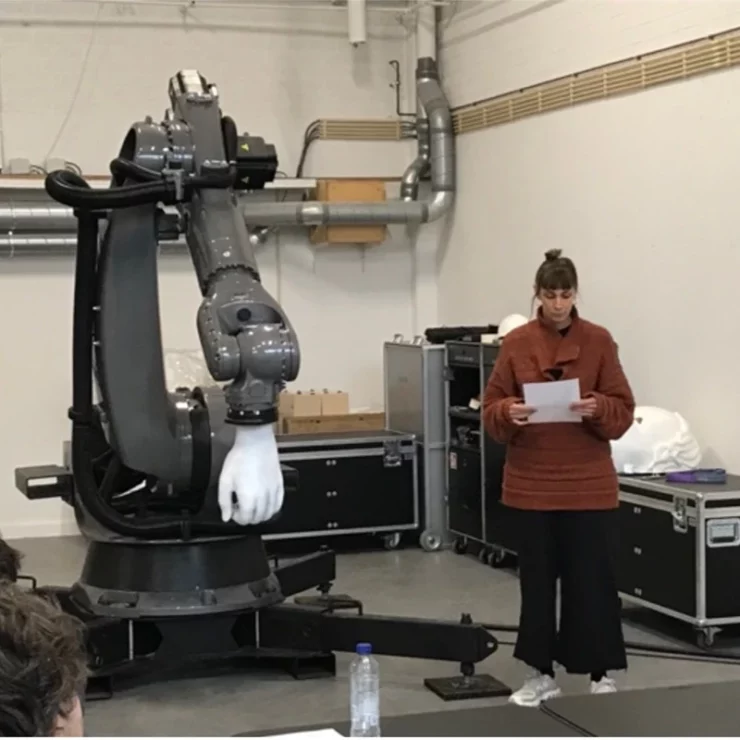Blog Posts
Intimacies of meaning-seeking: on a journey with the spoken word artist Sjaan in guidance of the robot KUKA – Stepan Laštuvka
December 2023
Based on the previous sprint focused on the voice and the sound of KUKA robots, this event brought into play questions of literary form and performance of literary texts. This larger theme was addressed together with Sjaan Flikweert, our guest and spoken word artist, who prepared three poems and two sequences of dramatic reading in interaction with the large KUKA robot. More specifically, Sjaan pointed out how intimacy served as an underlying motivation, asking how that may enable a mode of reflection or meaning-making in response to the texts and performance together with the robots. In line with the social theorist of art, Rudi Laermans, intimacy may be seen as a process of relating whereby aspects of human complexity become significant to another person and vice versa (Laermans 2015, 342). In the context of this sprint, how intimacy came about may be based on how the performance of the robot guides a particular reading of the poems or the other way around: how the texts and their reading create a specific way of relating to the robot. The KUKA robot became seen as offering scope for reflection on something that could be recognized as ‘human’ and, by extension, guiding an engagement with the present audience.
With this preparation, Sjaan performed three poems in two pre-designed sequences of the KUKA robot characterized by contrasting qualities of movement. In particular, the first sequence had been structured around slow motions, whereas the second was developed on fast and explosive movements of the robot. Moreover, for each sequence, the robot carried distinct visual features on its top part, either an unnaturally large hand or face (see fig. 1). The performances became constellations between the act of reading poems in interaction with the robots and their movement, sound and specific visual features. With this foundation, it unfolded as an exploration of how intimacy could develop and, in turn, to an extent collective modes of reflection and meaning-making take shape.
In response to Sjaan’s performance and its shared experience, a number of questions were discussed, particularly in consideration of space, point of view and the artistic expression of spoken word performance. In the first part, the performance invited questions about the significance of perspective and the (in)ability to attribute voice and sound to a specific person or entity. Specifically, considering how the performed text was written, the “I” of the narrator became ambiguous, which, in turn, raised questions about whether it refers to Sjaan reading the poem or the performing robot. The interplay between literary form and the performance of interaction between Sjaan and the robot offered a particular manner of seeing the robot as well as reading the poem. This instance had been pointed out to contribute a shared sense of intimacy associated with personal thoughts and feelings conveyed by the text, which made those to whom it may be attributed as ambiguous and collectively questioned as a result.
Furthermore, the tone of voice was emphasized to express a sense of vulnerability reflected in the interaction between the performers. Particularly, it was noticed based on Sjaan’s deliberate softening of voice in dialogue with the robot in close proximity, which, with its material composition and movements could pose a serious physical threat. By extension, the artistic skill of being vulnerable, in the course of the performance, then opened a particular scope for reflection. Perhaps this could be seen as a form of intimacy that unfolded in response to the performance in a manner of collective listening and witnessing of Sjaan; her voice and thoughts in dialogue with the sounds and movements of the KUKA, each at moments overpowering one another. As a result, it is possible to point out the levels of voice, literary form and bodily presence as means of either opening or closing space to feel (potentially intimate) and, in consequence, pursue novel paths of meaning-making.
The sprint emphasized the significance of how literary form and live performance of literature, as well as its spatial constellation, could realize specific modes of perceiving and meaning-making in interaction with the KUKA robots. More specifically, in response to Sjaan’s creative orientation in terms of intimacy, we can consider how it could shape the collective practice of meaning-making in the upcoming sprint events and how artistic strategies of intimacy may inspire the processes of developing upcoming public performances. In summary, the performance of Sjaan and the KUKA robot highlighted how spoken word may serve as an art form that shapes the modes of meaning-making in various settings, enabling a scope for reflection on particular socially relevant concerns with respect to robotics in the arts.
References
Laermans, Rudi. 2015. Moving Together: Making and Theorizing Contemporary Dance. Amsterdam: Valiz.


